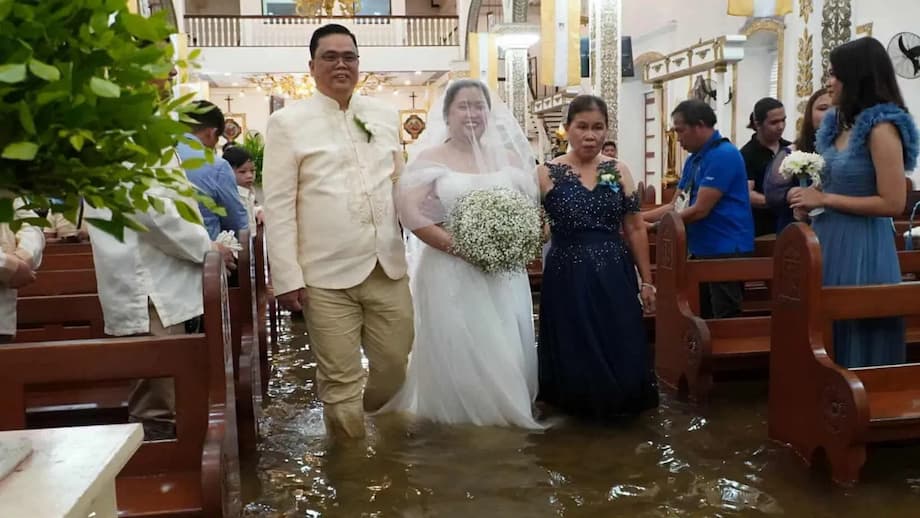Love Prevails Amid Floodwaters: The Viral Wedding at Barasoain Church
On July 22, 2025, the historic Barasoain Church in Malolos, Bulacan province, became the stage for a wedding that captured the world’s attention—not for its grandeur, but for the resilience and spirit it showcased. Jamaica Aguilar, dressed in a white gown and cathedral-length veil, waded through knee-deep floodwaters to marry her partner of ten years, Jade Rick Verdillo. The couple’s determination to proceed with their ceremony, despite the church being inundated by heavy rains from Typhoon Wipha and the seasonal monsoon, quickly went viral. Images and videos of the bride’s train floating on the water and guests rolling up their pant legs or leaving shoes on pews above the waterline spread across social media, symbolizing both Filipino resilience and the nation’s ongoing struggle with flooding.
- Love Prevails Amid Floodwaters: The Viral Wedding at Barasoain Church
- Why Do Flooded Weddings Keep Happening in the Philippines?
- The Human Cost: Health Risks and Disrupted Lives
- Filipino Resilience: Finding Joy in Adversity
- Government Response and the Road to Solutions
- The Broader Implications: Climate Change and Urban Vulnerability
- Looking Forward: Hope for Future Generations
- In Summary
The couple’s story resonated far beyond their circle of family and friends. As wedding guest Jiggo Santos put it,
You will see love prevailed because even against weather, storm, rains, floods, the wedding continued. It’s an extraordinary wedding.
But this was not an isolated event. In fact, similar scenes have played out before at Barasoain Church and other venues in the region, highlighting a persistent and worsening flood crisis in the Philippines.
Why Do Flooded Weddings Keep Happening in the Philippines?
The Philippines is no stranger to extreme weather. Located in the Pacific typhoon belt, the country is struck by an average of 20 tropical cyclones each year, with about half making landfall. Typhoon Wipha, which triggered the recent flooding, was the third major storm to hit the country in 2025 alone. The storm intensified seasonal monsoon rains, causing widespread flooding, landslides, and tidal surges. Over 80,000 people were forced into emergency shelters, and several lives were lost.
Yet, the frequency and severity of flooding in places like Metro Manila and Bulacan are not solely the result of natural forces. Experts point to a combination of factors that have made the situation increasingly dire:
- Decaying and Inadequate Sewage Systems: Much of Metro Manila’s drainage infrastructure is outdated and clogged, unable to handle the volume of water brought by heavy rains.
- Poor Urban Planning: Rapid urbanization has led to roads and buildings being constructed over natural waterways, disrupting the flow of water and exacerbating flooding.
- Poor Waste Management: Garbage often blocks drains and waterways, further impeding the city’s ability to cope with heavy rainfall.
- Climate Change: Scientists warn that climate change is making storms more intense and unpredictable, increasing the risk of severe flooding.
These systemic issues mean that even historic and culturally significant sites like Barasoain Church are not spared. The church, which has witnessed key moments in Philippine history, has now become a symbol of both the country’s vulnerability and its resilience.
The Human Cost: Health Risks and Disrupted Lives
For couples like Aguilar and Verdillo, the decision to proceed with a wedding in floodwaters is not taken lightly. Beyond the inconvenience and discomfort, there are real health risks. Floodwaters in urban areas often contain sewage and harmful bacteria, posing dangers such as leptospirosis and other waterborne diseases. The newlyweds reportedly took antibiotics after their ceremony as a precaution.
The impact of flooding extends far beyond weddings. In the aftermath of Typhoon Wipha, tens of thousands of Filipinos were displaced from their homes, seeking refuge in crowded emergency shelters. Schools and businesses were closed, transportation was disrupted, and basic services were stretched thin. In some cases, churches like Barasoain have hosted funerals in the same floodwaters just hours after a wedding, underscoring the relentless nature of the crisis.
Filipino Resilience: Finding Joy in Adversity
Despite these challenges, stories like Aguilar and Verdillo’s wedding highlight a defining trait of Filipino culture: resilience in the face of adversity. The couple’s attitude was echoed by many of their guests, who braved the floodwaters to witness the ceremony. As Verdillo explained,
We just mustered enough courage. We decided today because it is a sacrifice in itself. But there will be more sacrifices if we don’t push through today.
Aguilar added that challenges are a part of life, and this was just one they had to overcome together. Their story, and others like it, have become viral sensations, celebrated for their optimism and determination. In 2023, another couple married in the same church under similar conditions, further cementing the narrative of love and hope prevailing against the odds.
Government Response and the Road to Solutions
The recurring nature of these flooded weddings has drawn attention to the urgent need for systemic change. Critics argue that the government’s response to flooding has been reactive rather than proactive, focusing on short-term relief rather than long-term solutions. However, there are signs of progress. The Philippine government, in partnership with the World Bank, is working on a comprehensive flood management master plan for Metro Manila and surrounding areas. Investments are being made to repair and upgrade water pumping stations, improve drainage systems, and restore natural waterways.
Still, officials and residents alike acknowledge that these improvements will take time. The complexity of the problem—combining tides, storm surges, dam management, and urban planning—means that there is no quick fix. In the meantime, communities continue to adapt as best they can, relying on both official support and their own resourcefulness.
The Broader Implications: Climate Change and Urban Vulnerability
The story of flooded weddings in the Philippines is more than a viral curiosity; it is a stark illustration of the broader challenges facing many rapidly urbanizing, climate-vulnerable countries. As global temperatures rise, storms are expected to become more frequent and severe. Cities with inadequate infrastructure are at particular risk, and the poorest residents often bear the brunt of the consequences.
Experts warn that without significant investment in climate adaptation and disaster preparedness, events like the Barasoain Church wedding will become increasingly common—not just in the Philippines, but around the world. The need for resilient infrastructure, effective urban planning, and robust public health systems has never been more urgent.
Looking Forward: Hope for Future Generations
For newlyweds like Jade Rick Verdillo and Jamaica Aguilar, the hope is that their story will inspire both action and optimism. As Verdillo expressed after the ceremony, he remains hopeful that with continued investment and commitment, future couples will not have to wade through floodwaters to celebrate their union.
Their wedding, while extraordinary, is a reminder of the everyday challenges faced by millions of Filipinos. It is also a testament to the enduring power of love and community in the face of adversity. As the Philippines continues to grapple with the realities of climate change and urbanization, stories like this serve as both a warning and an inspiration—a call to action, and a celebration of the human spirit.
In Summary
- A Filipino couple’s wedding in a flooded Barasoain Church went viral, symbolizing resilience amid adversity.
- The event highlights the Philippines’ ongoing flood crisis, driven by typhoons, monsoon rains, poor infrastructure, and climate change.
- Flooded weddings have occurred before, underscoring systemic issues with urban planning and drainage.
- Flooding poses serious health and safety risks, displacing tens of thousands and disrupting daily life.
- The government is investing in long-term solutions, but progress is slow and complex.
- The story reflects broader global challenges of climate adaptation and urban vulnerability.
- Despite hardships, Filipino communities continue to find hope and joy, inspiring action and resilience worldwide.




